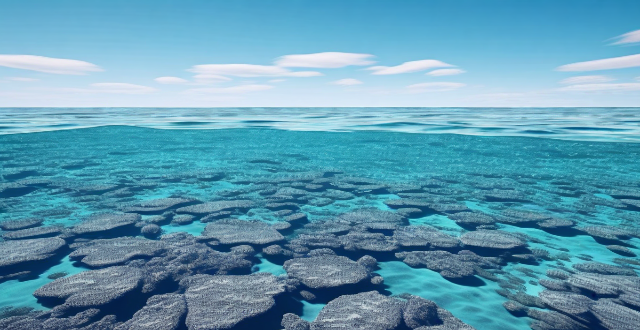The provided text discusses the impacts of global warming on marine life, particularly fish populations. It outlines how rising ocean temperatures alter habitats and affect metabolic rates; how ocean acidification disrupts calcification processes; how changes in currents and water circulation alter migration patterns and species ranges; the loss of coral reefs and its implications; the effects of extreme weather events on marine environments; and the challenges these changes present for resource management. The conclusion emphasizes the need for collective efforts to mitigate the effects of global warming on oceans.

Impacts of Global Warming on Marine Life and Fish Populations
Global warming, a long-term increase in Earth's average surface temperature due to human activities, has far-reaching consequences for marine ecosystems. The changes in ocean temperatures, acidity, and current patterns significantly affect the survival, distribution, and behavior of marine organisms, including fish populations. Here's a detailed exploration of these impacts:
Rising Ocean Temperatures
- Altered Habitats: As ocean temperatures rise, the habitats of many marine species shift or reduce in size. This can lead to fragmented populations and loss of biodiversity.
- Reduced Oxygen Levels: Warmer waters hold less dissolved oxygen, which is essential for marine life. Lower oxygen levels can stress or kill fish and other marine creatures.
- Metabolic Changes: Fish and other ectothermic organisms are sensitive to temperature changes. Higher temperatures can speed up their metabolism, affecting growth rates and reproductive cycles.
Ocean Acidification
- Disrupted Calcification: As CO2 dissolves into seawater, it forms carbonic acid, making the ocean more acidic. This affects organisms that rely on calcium carbonate for building shells or skeletons, such as corals and some plankton.
- Food Web Disruptions: Acidification can cause declines in shellfish and other organisms at the base of the food web, affecting predators like fish that depend on them for food.
Changes in Currents and Water Circulation
- Altered Migration Patterns: Many fish species follow specific ocean currents during migration. Changes in these currents can disrupt their routes, affecting breeding and feeding grounds.
- Shifting Species Ranges: As water temperatures change, species may move to new areas where conditions are more suitable. This can lead to competition with native species and potential ecosystem imbalances.
Loss of Coral Reefs
- Decreased Habitat Complexity: Coral reefs provide critical habitat for numerous fish species. Rising temperatures cause coral bleaching, reducing the structural complexity of reefs and the diversity of fish communities they support.
- Ecosystem Service Losses: Coral reefs offer services like coastal protection and nutrient cycling. Their degradation affects not only marine life but also human communities dependent on healthy reef systems.
Extreme Weather Events
- Storm-Induced Stress: Strong storms and increased wave action can disturb fish habitats, especially in shallow coastal areas.
- Salinity Changes: Intense rainfall or droughts can alter salinity levels in estuaries and nearshore environments, affecting the survival of fish that are adapted to specific salinity ranges.
Resource Management Implications
- Fisheries Management Challenges: Shifting fish populations require updated management strategies, including potential changes in fishing zones and catch limits.
- Conservation Priorities: Protecting vulnerable species and habitats becomes increasingly important as global warming progresses.
In conclusion, global warming poses significant challenges for marine life and fish populations. These impacts extend beyond individual species to entire ecosystems, requiring comprehensive understanding and proactive measures from the scientific community, policymakers, and the public to mitigate these effects and ensure the resilience of our oceans.